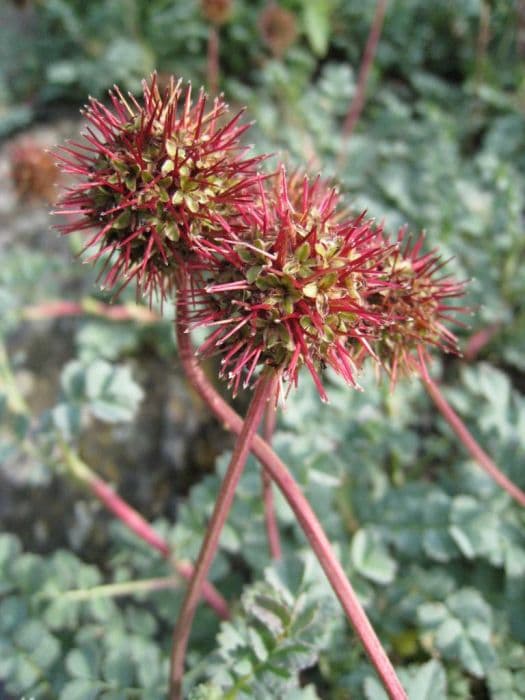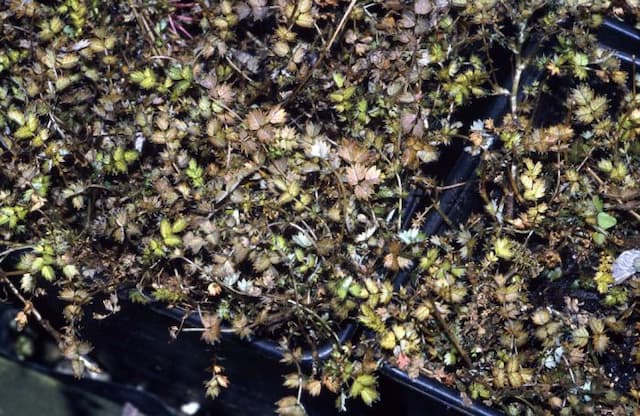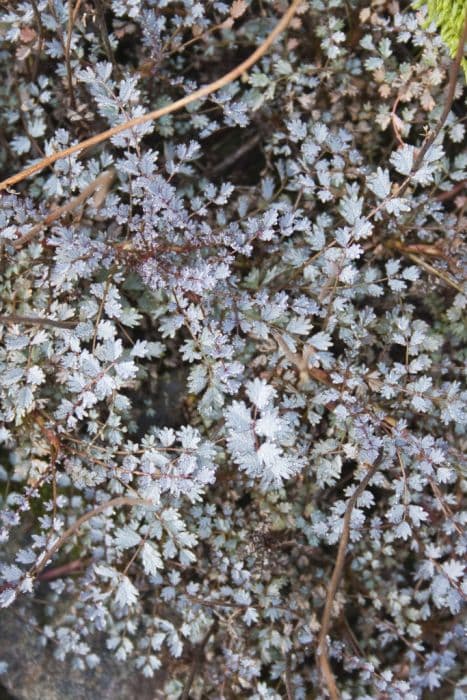Jargonelle pear Pyrus communis 'Jargonelle' (D)

ABOUT
The Pyrus communis 'Jargonelle' is more commonly known as the Jargonelle pear. This plant is a fruit tree that typically grows into a traditional tree shape with a single main trunk and a rounded canopy. The bark of the mature tree is grayish and may appear somewhat rough with age, featuring lenticels that stand out on the surface. The leaves of the Jargonelle pear tree are generally broad and oval-shaped with slight point at the apex. They display a glossy green surface and can have finely serrated edges, giving them a delicate and somewhat ruffled appearance on the margins. New foliage often comes in with a lighter, brighter green and matures to a deeper shade as the season progresses. Spring brings blooms to the Jargonelle pear tree, which consists of white flowers with a simple yet elegant structure. These flowers typically have five rounded petals and are gathered in clusters, which creates a stunning floral display against the backdrop of the fresh spring green leaves. The flowers are also known for their pleasant, subtle fragrance. As the flowering season ends, the tree sets fruit. The pears of the Jargonelle variety are known for their unique shape and coloring. They can have an elongated bottle shape, often with a bulbous base tapering to a narrower neck. The skin of these pears usually starts green and becomes more yellow as the fruit ripens, with some cultivars displaying a blush of another color. The flesh inside is creamy and soft when ripe, known for being juicy and sweet with a traditional pear flavor. Please note that any references to the specific dimensions or general size of the plant have been intentionally omitted in accordance with the given guidelines.
About this plant
 Names
NamesFamily
Rosaceae
Synonyms
Jargonelle Pear
Common names
Pyrus communis.
 Toxicity
ToxicityTo humans
The most common common name for Pyrus communis 'Jargonelle' is pear. Pears are not toxic to humans when consumed as the ripe fruit. The ripe fruit is edible and commonly eaten. However, the seeds contain amygdalin, a compound that can release cyanide when ingested in large enough quantities. Accidental ingestion of small amounts of seeds is generally not harmful due to the low concentration of amygdalin, but intentional or high consumption of crushed or chewed seeds could potentially lead to cyanide poisoning. Symptoms of cyanide poisoning may include dizziness, headache, nausea and vomiting, rapid breathing, rapid heart rate, and in extreme cases, convulsions, loss of consciousness, and can be fatal.
To pets
The most common common name for Pyrus communis 'Jargonelle' is pear. Pears, including the Jargonelle variety, are generally not toxic to pets when the ripe fruit is consumed in moderation. However, similar to humans, the seeds of the pear contain amygdalin, which can be converted to cyanide when digested. Cyanide can be harmful to pets if consumed in large amounts. Symptoms of cyanide poisoning in pets can include dilated pupils, difficulty breathing, panting, and shock. In severe cases, ingestion of a substantial quantity of seeds could be fatal. However, the seeds would need to be ingested in large quantities for cyanide poisoning to occur, and this is not common. The flesh of the pear itself is non-toxic to pets.
 Characteristics
CharacteristicsLife cycle
Perennials
Foliage type
Deciduous
Color of leaves
Green
Flower color
White
Height
13 feet (4 meters)
Spread
10 feet (3 meters)
Plant type
Tree
Hardiness zones
5
Native area
Asia Europe
Benefits
 General Benefits
General Benefits- Edible Fruits: The Pyrus communis 'Jargonelle', commonly known as the European Pear, produces sweet and juicy pears that can be eaten fresh, cooked, or canned.
- Ornamental Value: With its attractive blossoms in the spring and vibrant foliage in the autumn, the European Pear adds seasonal beauty to landscapes.
- Shade Provider: The tree's broad canopy offers shade and can help in cooling surrounding areas during hot summers.
- Wildlife Attraction: Flowers provide a source of nectar for bees and other pollinators, while fruits can feed birds and small mammals.
- Longevity: Being a hardy tree, it often lives for many decades, providing sustained benefits.
- Wood Uses: The wood of the European Pear is valued for woodworking and making musical instruments due to its fine grain and hardness.
 Medical Properties
Medical PropertiesThis plant is not used for medical purposes.
 Air-purifying Qualities
Air-purifying QualitiesThis plant is not specifically known for air purifying qualities.
 Other Uses
Other Uses- Pear 'Jargonelle' wood can be used for high-quality wood carving and crafting due to its fine grain and hardness, making it suitable for detailed work.
- The branches of the Jargonelle pear tree can be utilized in floral arrangements, especially when the tree is in blossom, adding natural beauty to the decor.
- Leaves of the Jargonelle pear can be crushed and used as a natural dye, offering a range of green hues to textile artisans.
- Pear fruit pulp from overripe Jargonelle pears can be composted to enrich soil with organic matter, improving garden health.
- Fermented Jargonelle pear juice can be used in the production of vinegar, providing a fruity twist to this kitchen staple.
- The wood of Jargonelle pear trees can be used to smoke meats and cheeses, imparting a subtle, sweet flavor.
- Ripe Jargonelle pears serve as a bait for trapping insects in gardens, as they are attracted to the sweet smell and juices.
- Thinly sliced Jargonelle pears can be dried to create natural, sweet snacks or used in decorative potpourri mixes.
- The sturdy branches of Jargonelle pear trees can be fashioned into rustic walking sticks or even garden stakes for supporting plants.
- Jargonelle pear leaves can be used as a natural mulch, providing nutrients to plants as they decompose and helping retain soil moisture.
Interesting Facts
 Feng Shui
Feng ShuiThe Pear tree is not used in Feng Shui practice.
 Zodiac Sign Compitability
Zodiac Sign CompitabilityThe Pear tree is not used in astrology practice.
 Plant Symbolism
Plant Symbolism- Prosperity: The Pear tree, to which Pyrus communis 'Jargonelle' belongs, is often associated with abundance and prosperity, as it yields a bountiful harvest of fruit when well-cared for.
- Longevity: Pear trees are known for their long lifespan, symbolizing health and longevity.
- Fertility: Pears are frequently connected to fertility and fecundity due to their rich and voluptuous shape, akin to the female form.
- Hope: Blossoming pear trees, with their delicate white flowers, can represent hope and the coming of spring after winter's dormancy.
- Affection: In some cultures, the giving of a pear is seen as a gesture of affection or a desire to share something precious, as pears can be delicate and require careful handling.
- Wisdom and Knowledge: Pear trees are occasionally linked with wisdom and knowledge, perhaps due to their age and embedded role in various cultures as a valuable resource.
 Water
WaterThe common pear ('Jargonelle' pear) should be watered deeply and slowly to ensure that the water reaches the root system; this is especially important during dry spells and the growing season. Young pear trees typically require watering once a week with about 2 gallons of water per session, but this can vary depending on soil conditions and climate. For established trees, it's best to check the soil moisture by digging a few inches around the base—if the soil is dry, it's time to water. During the winter months, reduce watering as the trees are dormant and require less moisture. Always avoid overwatering as it can lead to root rot and other issues.
 Light
LightThe 'Jargonelle' pear thrives best in full sun exposure, which means the plant should receive at least 6 to 8 hours of direct sunlight each day. An ideal spot for this pear tree is in an unobstructed area where it has access to plenty of sunlight throughout the day. Avoid planting in heavily shaded areas as insufficient light can hinder growth and fruit production.
 Temperature
TemperatureThe 'Jargonelle' pear prefers temperate climates and can typically withstand winter cold down to temperatures around -20 to -30 degrees Fahrenheit. During the growing season, the ideal temperature range is between 65 and 75 degrees Fahrenheit. It is important to protect the tree from extreme temperature fluctuations, particularly during blooming and fruit-setting periods, to prevent damage to the flowers and developing fruit.
 Pruning
PruningPruning 'Jargonelle' pear trees is essential to maintain tree health, encourage fruit production, and improve air circulation. Prune the tree during dormancy, typically in late winter to early spring, before new growth starts. Remove any dead, damaged, or diseased branches, and thin out crowded areas to allow sunlight to penetrate and air to flow freely. Additionally, shape the tree to keep it manageable and productive. Doing this annually will promote better yields and a more vigorous tree.
 Cleaning
CleaningNot needed
 Soil
SoilThe best soil mix for the common pear (Pyrus communis 'Jargonelle') is well-draining loamy soil with plenty of organic matter. Preferred soil pH ranges from slightly acidic to neutral (pH 6.0-7.0). Ensure soil has good fertility and moisture retention capabilities.
 Repotting
RepottingCommon pears, including the 'Jargonelle' variety, being fruit trees, aren't typically repotted as they are grown outdoors. However, if grown in containers, young trees may need repotting every 2-3 years into larger containers until they are planted out.
 Humidity & Misting
Humidity & MistingThe common pear 'Jargonelle' tolerates a wide range of humidity levels but performs best with moderate humidity typical of outdoor environments. Excessive humidity or dryness should be avoided to maintain plant health.
 Suitable locations
Suitable locationsIndoor
Growing indoors requires bright light and large space.
Outdoor
Full sun, well-drained soil, and regular pruning.
Hardiness zone
4-8 USDA
 Life cycle
Life cyclePyrus communis 'Jargonelle', commonly known as the Jargonelle pear, begins its life cycle with seed germination, where the seed requires stratification - a period of cold to break dormancy. Upon germination, the seed develops into a seedling and then transitions to the vegetative stage, producing stems, leaves, and a root system. As the plant matures, it enters the flowering stage, typically marked by white blossoms that attract pollinators for sexual reproduction. Following successful pollination, the flowers develop into pears, which is the fruiting stage. The tree continues to grow and produce fruit annually for many years, characterizing the adult, reproductive phase of the pear tree. Eventually, the pear tree may enter a period of decline where it produces less fruit before eventually dying.
 Propogation
PropogationPropogation time
Late winter-early spring
The European pear 'Jargonelle' is commonly propagated by grafting, which is the most popular method for many pears. This technique involves taking a scion, which is a piece of a mature plant's stem or branch, and attaching it to a rootstock, which is often a seedling or a clonal rootstock that provides the root system. Grafting typically takes place in late winter or early spring when the plants are still dormant. The scion should be about 6 to 8 inches (15 to 20 centimeters) long and contain several buds. The cut on both the scion and the rootstock must be clean and snugly fit together to ensure that the vascular tissues align properly, which is essential for the successful transfer of nutrients and water. The graft is then firmly bound and sealed to prevent drying and infection, and with proper care, the grafted pear tree begins to grow and eventually bears fruit comparable to the 'Jargonelle' variety.









